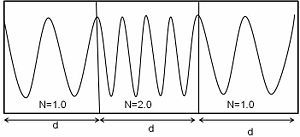Difference between revisions of "Total Internal Reflection"
Cmditradmin (talk | contribs) |
Cmditradmin (talk | contribs) |
||
| Line 1: | Line 1: | ||
[[Main_Page#Basics of Light|Return to Basics of Light Menu]] | [[Dispersion and Scattering of Light|Next Topic]] | [[Main_Page#Basics of Light|Return to Basics of Light Menu]] | [[Dispersion and Scattering of Light|Next Topic]] | ||
[[Image:Internal_reflect.jpg|thumb| | [[Image:Internal_reflect.jpg|thumb|400px|]] | ||
A critical concept in the case of optical fibers is the case total internal reflection. The bending of light as it goes into medium is related to the index of reflection of the materials. | A critical concept in the case of optical fibers is the case total internal reflection. The bending of light as it goes into medium is related to the index of reflection of the materials. | ||
| Line 18: | Line 18: | ||
<math>\theta_1c = sin^{-1}(\frac {n_2} {n_1})\,\!</math> | <math>\theta_1c = sin^{-1}(\frac {n_2} {n_1})\,\!</math> | ||
[[Image:Wavelength_inside.jpg|thumb|300px|As light passes from a vacuum into a medium with an index of refraction of 2, the wavelength get cut in half, and therefore it will take twice as long for to get through the medium. Again the frequency does not change. | |||
]] | |||
if <math>\theta_1> \theta_{1c}\,\!</math>: total reflection | if <math>\theta_1> \theta_{1c}\,\!</math>: total reflection | ||
| Line 24: | Line 25: | ||
for n<sub>1</sub> = 1.53 and n<sub>2</sub> = 1.50 : Θ<sub>1c</sub> = 78.6° | for n<sub>1</sub> = 1.53 and n<sub>2</sub> = 1.50 : Θ<sub>1c</sub> = 78.6° | ||
Revision as of 15:07, 11 May 2009
Return to Basics of Light Menu | Next Topic
A critical concept in the case of optical fibers is the case total internal reflection. The bending of light as it goes into medium is related to the index of reflection of the materials.
By Snells law when n1 > n2 then <math>\theta_1\,\!</math> is less than <math>\theta_2\,\!</math>.
As you decrease the angle theta 1 and bring the light closer to parallel with the interface you reach a critical angle theta1c where there is total internal reflection.
if <math>\theta_{1c}\,\!</math> keeps Increasing: <math>\theta_2\,\!</math> approaches 90°
for a critical angle Θ1c, Θ2 = 90°and the beam emerges along the surface
<math>\theta_2 = 90° \rightarrow sin \theta_2 = 1\,\!</math>
<math>\theta_1c = sin^{-1}(\frac {n_2} {n_1})\,\!</math>
if <math>\theta_1> \theta_{1c}\,\!</math>: total reflection
this is a critical process in optical fibers and waveguides because it can carry light for long distances. For these values of index of refraction you get a critical angle of 78.6 which means the light must be very nearly parallel to the interface.
for n1 = 1.53 and n2 = 1.50 : Θ1c = 78.6°
